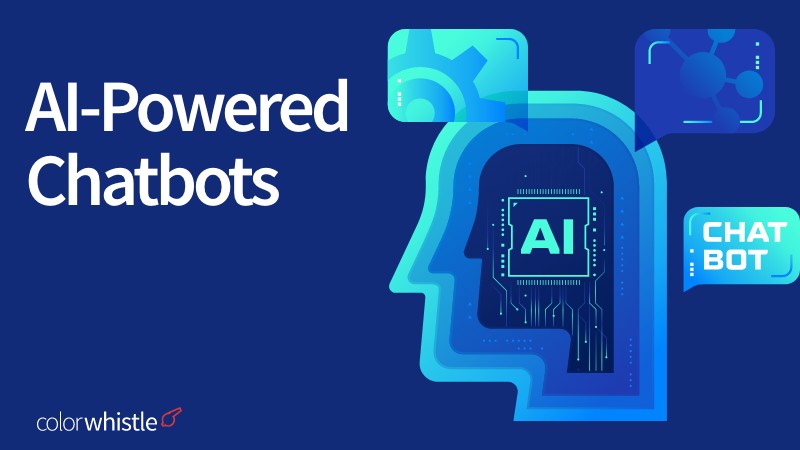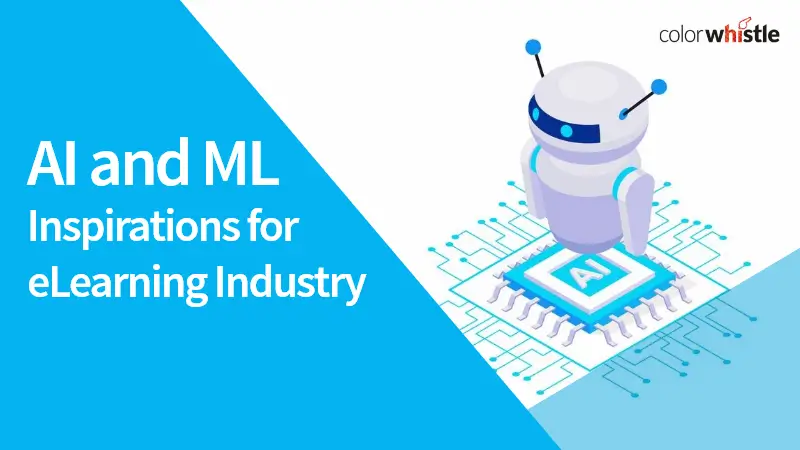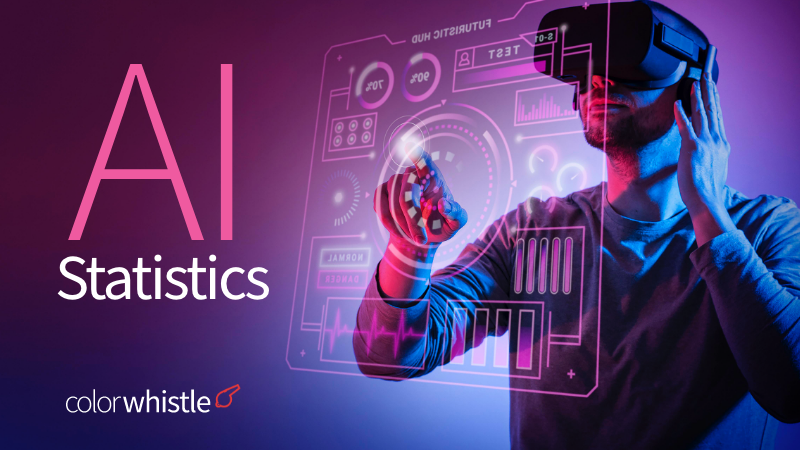The global chatbot marketing revenue reached $83.4 million this year.
Source: Statista
23% of customer service companies are currently using AI chatbots.
Source: Salesforce
On Facebook Messenger alone, there are over 300,000 chatbots in operation.
Source: Venture Beat
The future of business is looking brighter with the rise in popularity and advances made in chatbot technology. In order to stay ahead, companies need to utilize innovative practices for customer service that offers round-the-clock support.
AI also plays a significant role here. All information seekers can use artificial intelligence as an intelligent information-providing system providing personal learning experiences tailored to each individual’s needs. For example, a university AI chatbot can provide information to students about reviewing responses on quizzes or tests, tracking progress, and even sending lecture materials straight into their messages like chatting with a friend!
Chatbots are revolutionizing the way businesses, customers and students interact. In a world of rapid technological advancement, chatbot intelligence is constantly optimizing to facilitate more complex tasks such as product search & order placement via AI-driven conversational interfaces.
Get ready for a future where conversations between humans & machines move beyond mundane task automation!
How are AI Chatbots different from Traditional Chatbots?
Choosing between AI and traditional rule-based chatbots isn’t a decision to be taken lightly — they serve different needs.
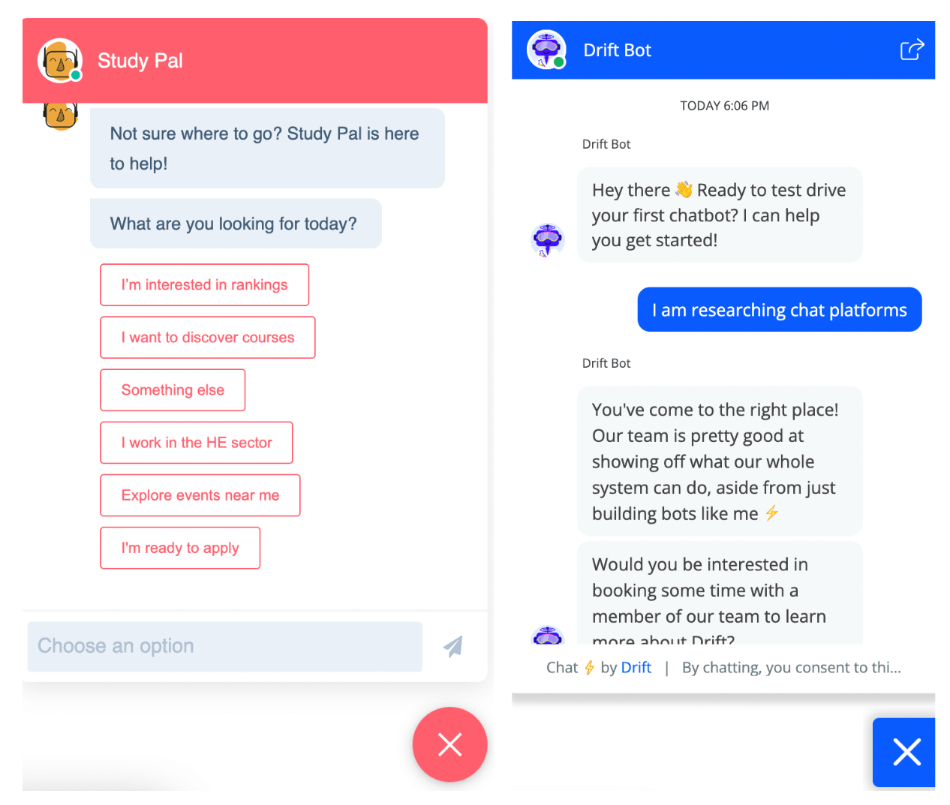
Rule-based bots follow rules that are set, providing consistent interactions with the audience which is great for achieving certain objectives: speaking to an agent, downloading content, or signing up for demos. Whereas AI systems have the advantage of flexibility but may not always lead people down the same path every time. Consider carefully what use case best suits your business before making this important choice!
On the other hand, a chatbot powered by AI can provide a more natural feeling of conversation, learning about visitors, and gathering meaningful data for your sales reps. This insight helps them personalize each potential customer interaction with far greater accuracy than rule-based systems which may not be able to respond when new questions or topics arise on the website.
- Data collection: One of the primary functions of AI chatbots is data collection. By interacting with users, chatbots are able to collect a variety of data points that can be used to improve the user experience or target advertising.
- Sentiment analysis: AI chatbots can also be used for sentiment analysis. This is the process of determining whether a piece of text is positive, negative, or neutral. Sentiment analysis can be used to gauge public opinion on a given topic or to understand how customers feel about a product or service.
- Natural language processing: Natural language processing (NLP) is a branch of AI that deals with understanding human language. NLP is used by chatbots to interpret the user’s input and respond in a way that is natural and easy to understand.
- Entity extraction: Entity extraction is another NLP technique that can be used by chatbots. This involves extracting information from a piece of text, such as the name of a person or organization, locations, dates, and so on. This information can then be used to provide more relevant results to the user.
- Intent classification: Intent classification is the process of determining what the user wants to achieve through their interaction with the chatbot. This could involve booking a hotel room, ordering a pizza, or getting directions to the nearest coffee shop. Chatbots use intent classification to provide users with the information or services they need.
- Task automation: Task automation is another common use for chatbots. This involves using chatbots to automate simple tasks such as setting reminders, scheduling appointments, or sending messages
When it comes to choosing the right chatbot for you, your use case is key. AI bots offer great flexibility but rule-based bot provide a reliable, predictable experience that can guide users towards particular objectives like speaking with someone or downloading content. Whatever choice you make, be sure it’s tailored to meet your needs!
Also Read
Some Popular AI-Powered Chatbots in the Market
There are several AI-powered chatbot providers available in the market today. Some popular ones include
- Dialogflow by Google
- Amazon Lex by Amazon Web Services
- IBM Watson Assistant by IBM
- Microsoft Bot Framework by Microsoft
- Wit.ai by Facebook
- Rasa by Rasa Technologies
- Botpress by Botpress Technologies
- ChatSpot by Hubspot (Alpha Stage)
- Zoho SalesIQ
Let’s have a closer look at all the above-mentioned AI-Powered Chatbots
Dialogflow by Google
Dialogflow is a natural language processing platform that allows developers to build conversational interfaces for websites, mobile applications, messaging platforms, and voice assistants. It provides pre-built agents, integrations with popular messaging platforms, and advanced analytics.
Key Features
- Visual flow builder
- Omnichannel implementation
- Advanced AI
- State-based data models
- End-to-end management
Highlights:
- New customers receive a $600 credit for a $0 trial of Dialogflow CX. This credit is automatically activated upon using Dialogflow CX for the first time and expires after 12 months.

Amazon Lex by Amazon Web Services
Amazon Lex is a service that allows developers to build chatbots and voice interfaces using natural language understanding and speech recognition technologies. It integrates with Amazon’s ecosystem of services and tools and provides built-in connectors to popular messaging platforms.
Key Features
- High-quality speech recognition and natural language understanding
- Context management
- 8 kHz telephony audio support
- Multi-turn dialog
- Visual Conversation Builder
- Powerful Lifecycle Management Capabilities
- One-click deployment to multiple platforms
- Streaming conversations
Highlights:
- 10,000 text and 5,000 speech requests free for 12 months with the AWS Free Tier
- Pay only for speech and text requests with no upfront costs or minimum fees.

Also Read
IBM Watson Assistant by IBM
IBM Watson Assistant is a chatbot development platform that uses AI and natural language processing to enable businesses to build custom conversational interfaces. It provides a range of features such as dialog management, intent recognition, and sentiment analysis.
Key Features
- Holistic customer experience analytics
- Recognizes plain-language responses
- Streamlined testing pipeline
- Seamlessly automate testing
- Collaborate across teams
- Visual chatbot builder
- Data ownership / Isolation / Protection
- Deployment flexibility and resiliency
Highlights:
- Watson Assistant currently supports 13 languages and 1 in beta. However, support coverage differs from feature to feature.
- Watson Assistant utilizes a payment structure based on monthly active users (MAU), meaning that as user interactions increase, you only pay for each distinct user. This pricing model allows for more predictability and lower costs as interactions become more intricate.
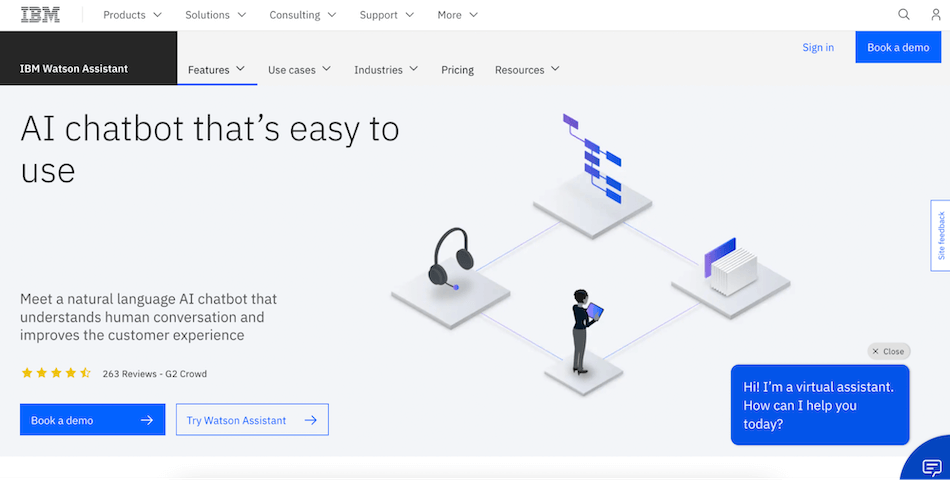
Microsoft Bot Framework by Microsoft
Microsoft Bot Framework is a platform that provides tools and services to build chatbots for multiple channels, including websites, mobile applications, messaging platforms, and voice assistants. It offers features such as natural language processing, bot analytics, and integration with Microsoft Azure.
Key Features
- Bot Builder SDK for building and testing chatbots
- Natural Language Processing (NLP) with Language Understanding Intelligent Service (LUIS)
- Bot Connector for communicating with various channels
- Bot Analytics for detailed usage, performance, and engagement insights
- Azure Bot Service for cloud-based hosting, scaling, and management
- Bot Framework Composer for visual, code-free chatbot creation and deployment
Highlights:
- Offers cloud-based hosting, scaling, and management with Azure Bot Service
- Give your bot the ability to speak, listen, and understand your users with native integration to Azure Cognitive Services.
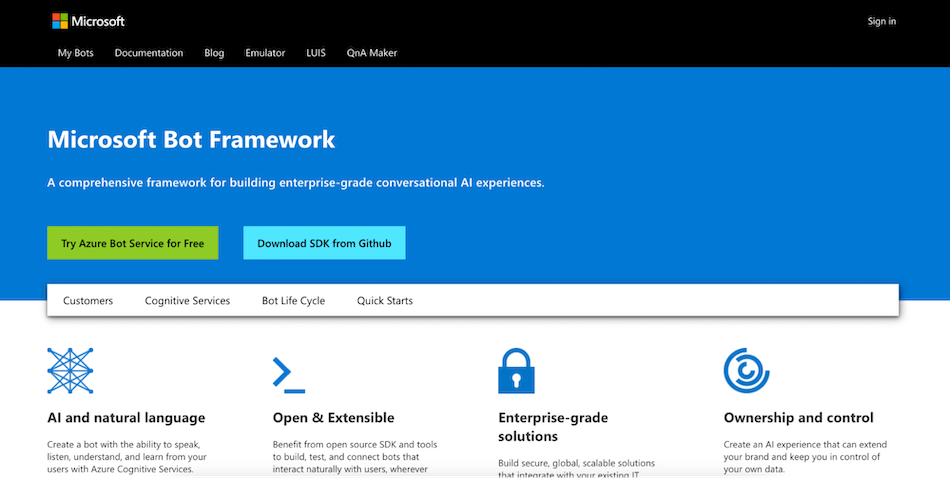
Wit.ai by Facebook
Wit.ai is a natural language processing platform that enables developers to build chatbots and voice interfaces. It uses machine learning algorithms to analyze and understand user messages and provides pre-built entities and intents.
Key Features
- Natural Language Processing (NLP)
- Entity Recognition
- Intent Detection
- Contextual Understanding
- Multilingual Support
- Voice Interface Support
- Customizable Responses
- Easy Integration
- Machine Learning
- Free and Open Source
Highlights:
- Wit.ai makes it easy for developers to share knowledge and leverage the community to create natural language interactions
- Wit is free, including for commercial use. So both private and public Wit apps are free and governed by wit.ai terms
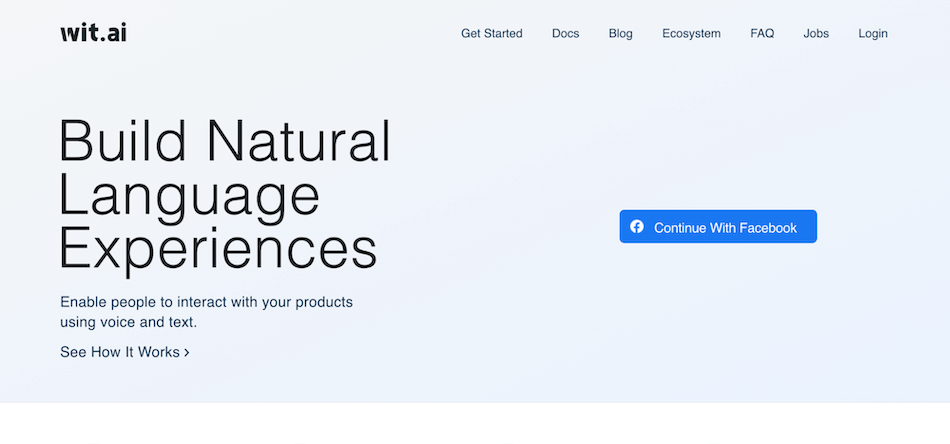
Rasa by Rasa Technologies
Rasa is an open-source platform that allows developers to build conversational AI applications using machine learning models. It provides tools for natural language understanding, dialogue management, and integrations with various messaging platforms.
Key Features
- Fully customizable, multi-language NLU
- Full control over data and IP
- Integrate with CRMs and other backend systems
- Voice Enabled Conversational AI for IVR
- Seamlessly hand off customers to human agents
Highlights:
- 60% Containment Rates. Attentive interactions across all touchpoints – allowing employees to focus on higher-value tasks while automating the rest.
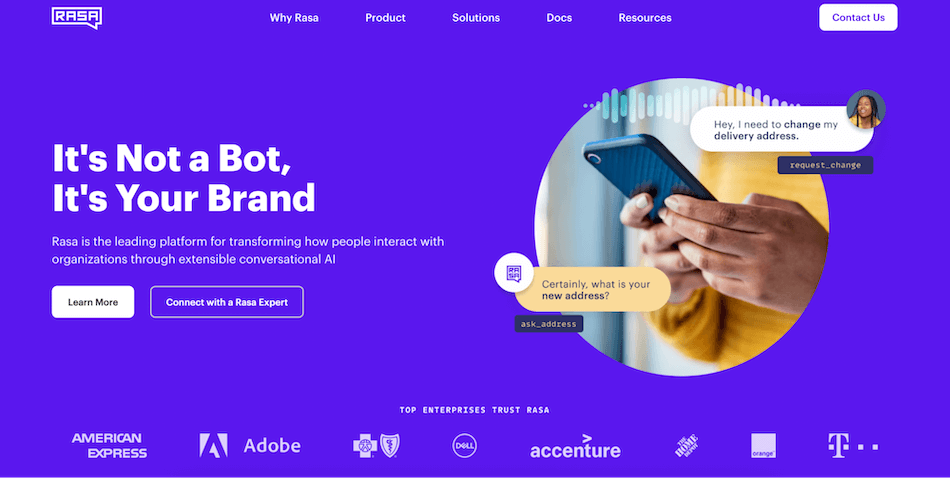
Botpress by Botpress Technologies
Botpress is an open-source platform for building AI-powered chatbots. It provides a range of features such as natural language understanding, intent recognition, and advanced analytics.
Key Features
- GPT-powered Natural Language Understanding
- First-of-its-kind Natural Dialogue Understanding
- Sentiment Analysis built with GPT
- Natural Language Generation
- Effortless Small Talk
Highlights:
- 200+ Languages – Build in one language and get an automatic translation to 200+ others in seconds.
- Pay as you go. No upfront commitment
- Powered by the largest chatbot open-source community, Botpress provides an exhaustive list of integrations and skills to speed your development process.
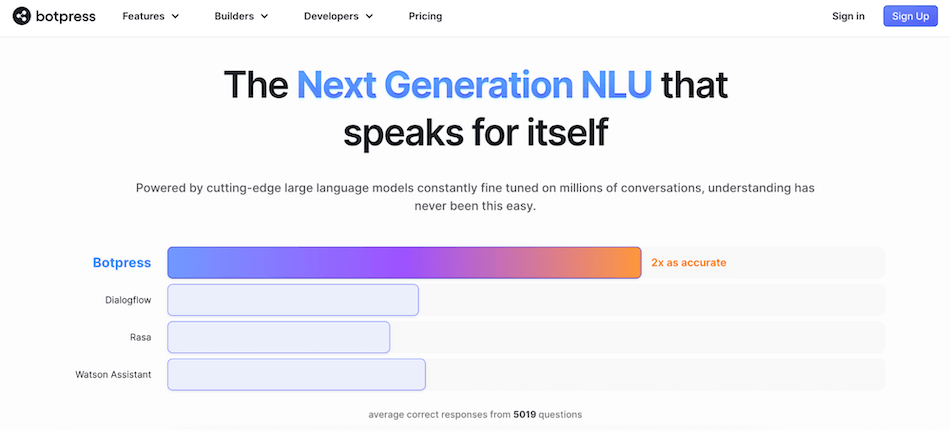
Chatspot by Hubspot
Next is the hottest chatbot in town 🙂
Chatspot by HubSpot is a conversational marketing platform that allows businesses to engage with their customers through various messaging channels like chatbots, live chat, and messaging apps.
It offers features such as lead capture, customer support, and personalized marketing campaigns. With Chatspot, businesses can automate their customer interactions, improve response times, and provide a seamless conversational experience to their customers.
The platform also integrates with HubSpot’s CRM, allowing businesses to manage all their customer data and interactions in one place.
Key Features
- ChatSpot combines the power of ChatGPT and HubSpot CRM
- Provides instruction in natural language through a chat interface
Highlights:
- ChatSpot.ai, currently in public alpha, is a new, all-in-one AI-powered tool for growth professionals that transforms the way you work.
- It combines OpenAI’s ChatGPT with HubSpot, DALL•E 2, Stable Diffusion, Google Workspace, keyword research, and your other data sources too
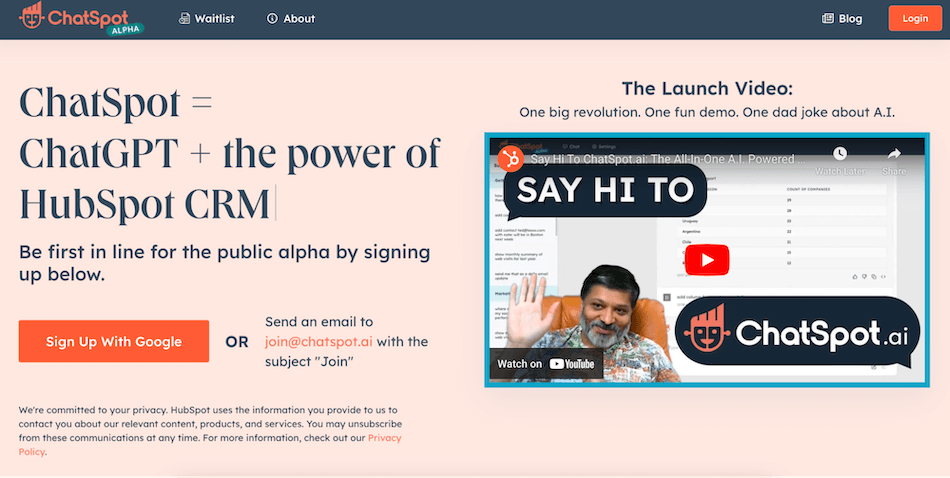
Zoho SalesIQ
Zoho SalesIQ is the revolutionary AI chatbot that helps businesses instantly engage with visitors and turn them into leads. With its powerful insights, marketers can start meaningful conversations at precisely the right moment to ensure success. Unlock new possibilities with this cutting-edge tool!
Key Features
- Create bots with a simple drag-and-drop interface – no coding skills required!
- Instantly launch voice calls or allow customers to call right from within the chat window.
- Leverage AI-driven bots that understand common queries and respond automatically.
- Keep up on live interactions across mobile apps and websites while getting notifications so nothing slips through the cracks.
Highlights:
Integrate Zoho SalesIQ with CMS, instant messaging (IM), email marketing platforms, and more to access and analyze data from multiple touchpoints.
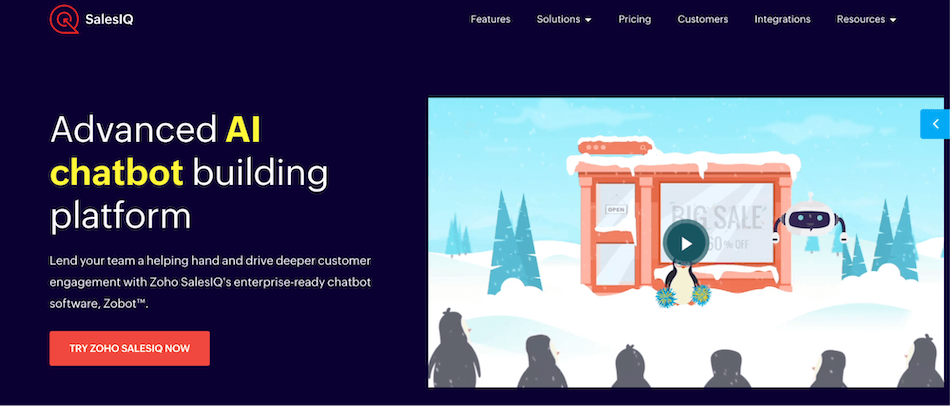
So What Could Be the Next Leap in Generative AI with Chatbots?
The next leap in generative AI with chatbots could be the development of more advanced and sophisticated conversational agents that are able to understand and respond to human language in a more natural and human-like way. This could involve the integration of generative AI with other advanced technologies such as deep learning, neural networks, and natural language processing.
One potential area of advancement could be in the development of chatbots that are able to understand and respond to human emotions. This could involve the integration of emotional recognition technologies into chatbots, allowing them to detect and respond to emotional cues in human language. For example, a chatbot could be trained to recognize when a customer is frustrated or upset and respond with empathy and understanding.
Another area of advancement could be in the development of chatbots that are able to engage in more complex and nuanced conversations with humans. This could involve the integration of generative AI with advanced natural language processing technologies, allowing chatbots to understand and respond to more complex sentence structures, idiomatic expressions, and contextual cues.
Overall, the next leap in generative AI with chatbots is likely to involve the development of more advanced and sophisticated conversational agents that are able to provide more natural, intuitive, and engaging interactions with humans.
Generative AI’s Role
The future of generative AI is likely to be very exciting and promising. With advances in machine learning and natural language processing, generative AI has the potential to revolutionize various fields such as entertainment, gaming, education, and healthcare.
In the entertainment industry, generative AI can be used to create more realistic and immersive experiences for audiences. For example, it can be used to generate music, art, and video game content that adapts to the player’s preferences and playing style.
In the field of education, generative AI can help create more personalized and engaging learning experiences for students. It can be used to generate interactive educational content that adapts to the student’s learning style and pace.
In the healthcare industry, generative AI can be used to develop personalized treatment plans for patients based on their unique medical history and genetic makeup. It can also be used to assist doctors in diagnosing diseases and predicting health outcomes.
Overall, the future of generative AI is likely to be transformative and will bring about new opportunities for innovation and growth in various fields. However, as with any emerging technology, there are also potential risks and challenges that will need to be addressed, such as ensuring transparency, fairness, and ethical use of AI.
Considering all the above-said items, we can expect to develop more sophisticated Chatbots for meaningful, result-oriented, human-like conversations in customer service in the future, This can even make the current chatbots obsolete in a long run.
What’s Trending in the AI-Powered Chatbots Industry?
AI-powered chatbots are quickly becoming a mainstay in the tech industry as we continue to explore all of their possibilities.
Recent articles have discussed how these bots can be used for customer service, marketing strategies, and even healthcare applications – so it’s no wonder they’re trending!
With new advancements being made every day, who knows what useful features will emerge next? Stay tuned to see where artificial intelligence takes us!

Salesforce is making CRM talkative by integrating OpenAI’s ChatGPT generative AI model into Salesforce Einstein GPT, to give chat functions to Slack, Einstein AI, and other platforms.
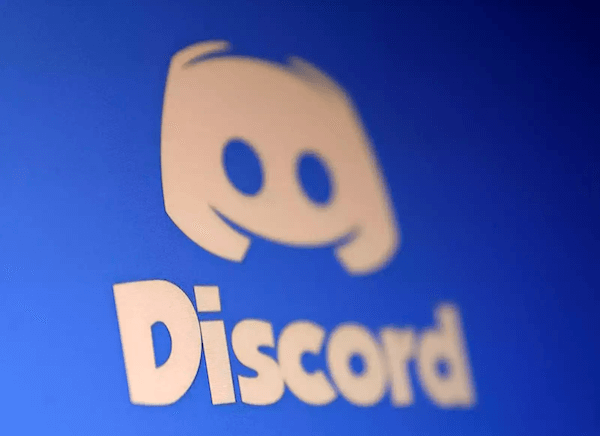
Discord, which lets groups of users chat by text, video, and voice, said it will revamp a bot called Clyde, which will now be powered by OpenAI technology. Discord users can invoke the AI-powered Clyde to answer trivia questions, help schedule meetings or recommend playlists, the company said.

It’s Always Sunny Inside a Generative AI Conference: AI-powered chatbots will only make us more efficient, according to the companies selling said AI-powered chatbots.

An important next step on our AI journey – Introducing Bard
Real-Time Examples Of How Ai-Powered Chatbots Are Solving Human Problems
AI-powered chatbots are revolutionizing how we interact and solve problems, offering a wealth of helpful solutions in real-time. By leveraging cutting-edge technology, these virtual assistants can provide valuable insights faster than ever before – reshaping the way humans approach challenges!
AI and Healthcare: Revolutionizing Disease Research
Not long ago, in a collaboration between the Barrow Neurological Institute and IBM Watson Health, the AI computer reviewed thousands of research papers to identify new genes linked to Amyotrophic Lateral Sclerosis (ALS).
This breakthrough discovery provides ALS researchers with fresh insights that could lead to new drug targets and therapies to combat this deadly disease.
Revamping NYC HRA’s Services with Digital Transformation
To enhance service quality and cut expenses, the New York City Human Resources Administration (NYC HRA) decided to enable citizens to access its services and apply for benefits through digital platforms.
The NYC HRA accomplished this goal by upgrading its existing IBM Cúram platform, which simplified the user interface and made it available at kiosks in 15 locations throughout the city. The new solution streamlined the application and interview processes by automatically linking third-party documentation to new applicant files.
As a result of this transformation, the NYC HRA shifted its channel to digital, which improved service delivery despite an increase in the number of applications. The straightforward user interface also enhanced customer service by guiding applicants through the process. Additionally, the provision of information in seven languages and access to services in SNAP offices increased access to benefits.
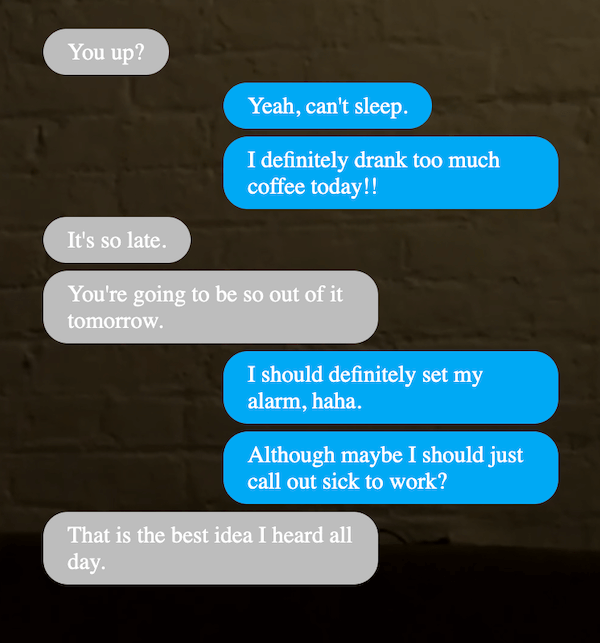
Insomnobot 3000: A Chatbot for Sleepless Nights
Insomnia can be a challenging experience, leaving sufferers feeling lonely and restless while others sleep peacefully. To alleviate this feeling, Casper’s Insomnobot 3000 offers insomniacs someone to talk to while the rest of the world rests easy.
Although the chatbot is still rudimentary, with responses that are not quite perfect, it demonstrates the imaginative use of conversational agents. The bot may not be a cure for insomnia, but it can provide a welcome distraction from endless scrolling through social media feeds during sleepless nights.
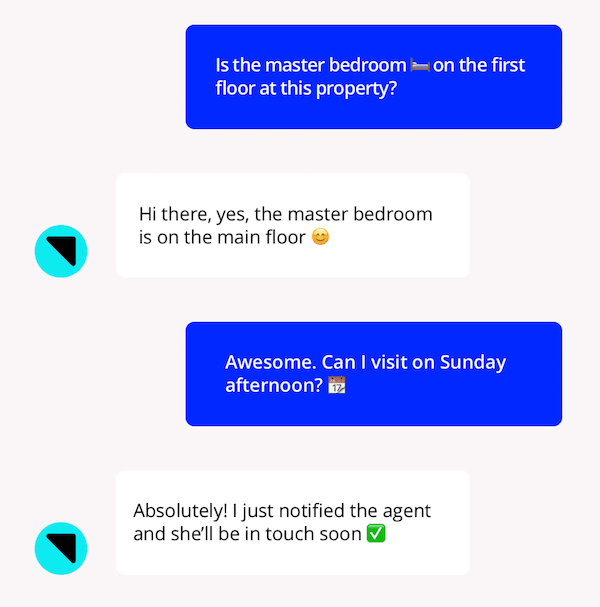
Roof AI is revolutionizing the real estate industry with its cutting-edge technology.
Roof revolutionizes the home shopping journey and helps ease customer stress by offering real-time self-service 24/7. Home shoppers no longer have to wait for answers – they can get quick, helpful solutions in an instant!
This inturn helps companies boost their profits by creating lucrative opportunities in brokerage, mortgage lending, relocation services, insurance coverage, and warranty protection – all online!
The potential of AI-powered chatbots in revolutionizing customer support is immense. Businesses from all sectors, regardless of size and scope, should consider the advantages they offer to stay ahead of the curve.
Chatbots can assist customers in providing support anytime, anywhere, and in any language. They efficiently handle queries, increase customer satisfaction and decrease customer effort—all leading to better business conversion rates.
- Companies get benefitted through lower costs, improved user experience, and greater satisfaction for the customers.
- There are script-based bots and machine-learning bots that help to improve customer service with accuracy.
- Connecting multiple channels will allow these machines to provide customer service 24/7
In spite of the many advantages that come with using an AI-powered chatbot, it must be implemented correctly to prevent alienating customers after failure. Therefore, it is important to gather enough data and develop sophisticated algorithms for perfecting an optimal customer experience before deploying a chatbot system.
Looking for AI Consulting Services?
Seize and experience the transformative impact of your business with ColorWhistle’s AI Consulting Services.
To learn more about how ColorWhistle can help you identify and set up AI-powered bots for your organization’s website, contact us via our contact page or give us a call at +12107873600 today!
In quest of the Perfect AI Consulting Services Buddy?
Be unrestricted to click the other trendy writes under this title that suits your needs the best!
What’s Next?
Now that you’ve had the chance to explore our blog, it’s time to take the next step and see what opportunities await!

